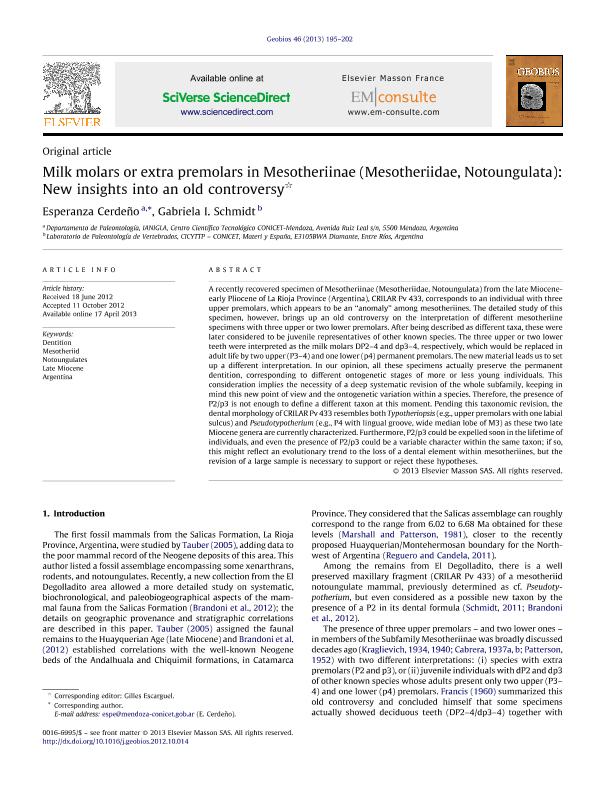Mostrar el registro sencillo del ítem
dc.contributor.author
Cerdeño Serrano, Maria Esperanza

dc.contributor.author
Schmidt, Gabriela Ines

dc.date.available
2015-12-17T18:25:01Z
dc.date.issued
2013-06
dc.identifier.citation
Cerdeño Serrano, Maria Esperanza; Schmidt, Gabriela Ines; Milk molars or extra premolars in Mesotheriinae (Mesotheriidae, Notoungulata): New insights into an old controversy; Elsevier France-Editions Scientifiques Medicales Elsevier; Geobios; 46; 3; 6-2013; 195-202
dc.identifier.issn
0016-6995
dc.identifier.uri
http://hdl.handle.net/11336/3011
dc.description.abstract
A recently recovered specimen of Mesotheriinae (Mesotheriidae, Notoungulata) from the late Miocene-early Pliocene of La Rioja Province (Argentina), CRILARPv433, corresponds to an individual with three upper premolars, which appears to be an "anomaly" among mesotheriines. The detailed study of this specimen, however, brings up an old controversy on the interpretation of different mesotheriine specimens with three upper or two lower premolars. After being described as different taxa, these were later considered to be juvenile representatives of other known species. The three upper or two lower teeth were interpreted as the milk molars DP2-4 and dp3-4, respectively, which would be replaced in adult life by two upper (P3-4) and one lower (p4) permanent premolars. The new material leads us to set up a different interpretation. In our opinion, all these specimens actually preserve the permanent dentition, corresponding to different ontogenetic stages of more or less young individuals. This consideration implies the necessity of a deep systematic revision of the whole subfamily, keeping in mind this new point of view and the ontogenetic variation within a species. Therefore, the presence of P2/p3 is not enough to define a different taxon at this moment. Pending this taxonomic revision, the dental morphology of CRILARPv433 resembles both Typotheriopsis (e.g., upper premolars with one labial sulcus) and Pseudotypotherium (e.g., P4 with lingual groove, wide median lobe of M3) as these two late Miocene genera are currently characterized. Furthermore, P2/p3 could be expelled soon in the lifetime of individuals, and even the presence of P2/p3 could be a variable character within the same taxon; if so, this might reflect an evolutionary trend to the loss of a dental element within mesotheriines, but the revision of a large sample is necessary to support or reject these hypotheses.
dc.format
application/pdf
dc.language.iso
eng
dc.publisher
Elsevier France-Editions Scientifiques Medicales Elsevier

dc.rights
info:eu-repo/semantics/openAccess
dc.rights.uri
https://creativecommons.org/licenses/by-nc-nd/2.5/ar/
dc.subject
Dentition
dc.subject
Mesotheriid
dc.subject
Notoungulates
dc.subject
Late Miocene
dc.subject.classification
Paleontología

dc.subject.classification
Ciencias de la Tierra y relacionadas con el Medio Ambiente

dc.subject.classification
CIENCIAS NATURALES Y EXACTAS

dc.title
Milk molars or extra premolars in Mesotheriinae (Mesotheriidae, Notoungulata): New insights into an old controversy
dc.type
info:eu-repo/semantics/article
dc.type
info:ar-repo/semantics/artículo
dc.type
info:eu-repo/semantics/publishedVersion
dc.date.updated
2016-03-30 10:35:44.97925-03
dc.journal.volume
46
dc.journal.number
3
dc.journal.pagination
195-202
dc.journal.pais
Francia

dc.journal.ciudad
Paris
dc.description.fil
Fil: Cerdeño Serrano, Maria Esperanza. Consejo Nacional de Investigaciones Científicas y Técnicas. Científico Tecnológico Mendoza. Instituto Argentino de Nivología, Glaciología y Ciencias Ambientales; Argentina
dc.description.fil
Fil: Schmidt, Gabriela Ines. Consejo Nacional de Investigaciones Científicas y Técnicas. Centro de Investigaciones Científicas y Transferencia de Tecnología a la Producción; Argentina
dc.journal.title
Geobios

dc.relation.alternativeid
info:eu-repo/semantics/altIdentifier/doi/http://dx.doi.org/10.1016/j.geobios.2012.10.014
dc.relation.alternativeid
info:eu-repo/semantics/altIdentifier/url/https://www.sciencedirect.com/science/article/pii/S0016699513000302
Archivos asociados
